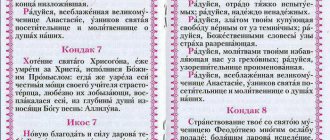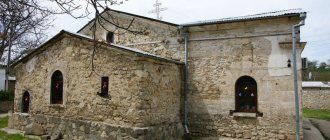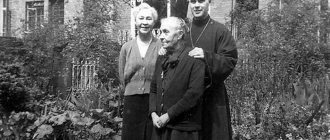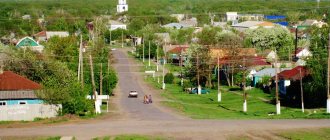This icon still reminds us of the tragic life of the Holy Martyr Elizabeth Feodorovna. The martyr's cross in the right hand of the Saint and the Cathedral of the Marfo-Mariinsky monastery - this is how the icon of Elizabeth Feodorovna is depicted.
Memorial Days:
- February 5 – Cathedral of Kostroma Saints
- February 11 – Cathedral of Ekaterinburg Saints
- July 18
- October 11 – Finding of relics
Like the Catholic Saint Elizabeth of Hungary, who founded the Eisenach Hospital for the Poor, she became famous for following the ideals of the Church of Christ.
History of Saint Elizabeth Feodorovna
Saint Elizabeth Feodorovna was born in Darmstadt, Germany on October 20 (now November 1), 1864. She became the second child in the family of Duke Ludwig IV of Hesse-Darmstadt and the daughter of Queen Victoria of England, Princess Alice. Thanks to the traditions of old England, children were brought up in strictness - they wore simple clothes and ate ordinary food. Their mother raised them on the basis of Christian precepts and put compassion and love for their neighbors into their hearts. That is why, from childhood, Elizabeth was distinguished by her religiosity and paid her respect to her distant relative, Elizabeth of Thuringia.
Unfortunately, Elizabeth's family lost a child - in 1873, her three-year-old brother, Friedrich, left them. And in 1876, diphtheria took away one of Elizabeth’s sisters, and then her mother Alice. Then Saint Elizabeth became a support to her father and surviving brother and sisters.
At the age of 20, Elizabeth married Grand Duke Sergei Alexandrovich. They both lived in a spiritual marriage, as they both took a secret vow to remain virgins for life.
The husband was a very religious person, and the princess supported him in this. Being a Protestant, Elizabeth firmly decided to convert to Orthodoxy, and sent a telegram to her father with the hope of his blessing. However, the father sent his daughter a letter back with lines about pain and suffering about her thoughts. Despite her father’s refusal, Elizabeth, showing courage, secretly converted to Orthodoxy.
On April 13 (25), on Lazarus Saturday, the sacrament of confirmation of Grand Duchess Elizabeth Feodorovna was performed, leaving her former name, but in honor of the holy righteous Elizabeth - the mother of St. John the Baptist
During the Russo-Japanese War, Elizaveta Fedorovna organized assistance to the front.
In 1905, having buried her husband from a terrorist bomb, the Saint visited her husband’s killer in prison, where she forgave him. The Gospel is what Righteous Elizabeth left behind. The icon and image of which are reflected in the center next to the Royal Passion-Bearers.
Soon, Elizabeth, having collected her jewels, used them to create the monastery of mercy. And in 1909 she herself was dressed in monastic robes. Elizabeth and her sisters raised many adopted children in their monastery.
After the First World War and the 1917 Revolution, the entire royal family was arrested and soon thrown into an iron mine shaft. Local peasants heard the singing of prayers coming from the mine for several days. Her body, untouched by decay, was transferred to the Church of Mary Magdalene in Jerusalem several years later.
The Russian Orthodox Church canonized Saint Elizabeth and Sister Barbara in 1992, and the royal martyrs in 2000.
We recommend reading: Icon of John Climacus
Elisaveta Feodorovna – tree
Article from the encyclopedia “Tree”: drevo-info.ru
| Grand Duchess Elizaveta Feodorovna |
Elisaveta Feodorovna
(1864 – 1918), Grand Duchess, Venerable Martyr
Commemorated July 5, January 25 (Greek [1]), in the Councils of Ekaterinburg, Moscow and St. Petersburg saints and in the Council of New Martyrs and Confessors of the Russian Church
Born on October 20, 1864 in the Protestant family of the Grand Duke of Hesse-Darmstadt Ludwig IV and Princess Alice, daughter of Queen Victoria of England. Ella was the second child in the family. The children were brought up in the traditions of old England.
Their life passed according to the rules strictly established by their mother. Children's clothing and food were very basic. The three eldest daughters did the housework themselves: they cleaned the rooms, beds, and lit the fireplace.
Subsequently, Elisaveta Feodorovna said: “They taught me everything in the house.”
In 1884, she married Grand Duke Sergei Alexandrovich, brother of Emperor Alexander III of Russia.
Seeing the deep faith of her husband, the princess with all her heart sought the answer to the question - which religion is true? She prayed fervently and asked the Lord to reveal His will to her. On April 13, 1891, on Lazarus Saturday, the rite of acceptance into the Orthodox Church was performed over Elisaveta Feodorovna. In the same year, Grand Duke Sergei Alexandrovich was appointed Governor-General of Moscow.
Visiting churches, hospitals, orphanages, nursing homes and prisons, the princess saw a lot of suffering. And everywhere she tried to do something to alleviate them. After the start of the Russian-Japanese War in 1904, Elisaveta Feodorovna helped the front and Russian soldiers in many ways. She worked until she was completely exhausted.
| Grand Duchess Elizaveta Feodorovna and Grand Duke Sergei Alexandrovich |
On February 4, 1905, Prince Sergei Alexandrovich died from a bomb explosion by a revolutionary terrorist.
Elisaveta Feodorovna rushed to the scene of the explosion and saw a picture that surpassed human imagination in its horror.
Silently, without screaming or tears, kneeling in the snow, she began to collect and place on a stretcher the body parts of her beloved husband, who had been alive just a few minutes ago.
In the hour of difficult trials, Elisaveta Feodorovna asked for help and consolation from God. The next day she received Holy Communion in the church of the Chudov Monastery, where her husband’s coffin stood.
On the third day after the death of her husband, Elisaveta Feodorovna went to prison to see the killer. She didn't hate him. The Grand Duchess wanted him to repent of his terrible crime and pray to the Lord for forgiveness.
She even submitted a petition to the Emperor to pardon the killer.
Elisaveta Feodorovna decided to devote her life to the Lord through serving people and create a monastery of work, mercy and prayer in Moscow. She bought a plot of land with four houses and a large garden on Bolshaya Ordynka Street.
In the monastery, which was named Marfo-Mariinskaya in honor of the holy sisters Martha and Mary, two churches were created - Marfo-Mariinsky and Pokrovsky, a hospital, which was later considered the best in Moscow, and a pharmacy in which medicines were dispensed to the poor free of charge, an orphanage and a school .
Outside the walls of the monastery, a house-hospital was set up for women suffering from tuberculosis.
On February 10, 1909, the monastery began its activities. On April 9, 1910, during the all-night vigil, Bishop Trifon of Dmitrov (Turkestan) (+1934), according to the rite developed by the Holy Synod, consecrated the nuns to the title of sisters of the cross of love and mercy. The sisters took a vow, following the example of the nuns, to spend a virgin life in work and prayer.
The next day, during the Divine Liturgy, Saint Vladimir, Metropolitan of Moscow and Kolomna, placed eight-pointed cypress crosses on the sisters, and elevated Elisaveta Feodorovna to the rank of abbess of the monastery. The princess said that day: “I am leaving the brilliant world...
but together with you all I ascend into a greater world - the world of the poor and suffering.”
| Grand Duchess Elizaveta Feodorovna |
At the Martha and Mary Convent, Princess Elisaveta Feodorovna led an ascetic life: she slept on a wooden bed without a mattress, often for no more than three hours; she ate food very moderately and strictly observed fasts; at midnight she got up for prayer, and then went around all the hospital wards, often remaining at the bedside of a seriously ill patient until dawn. She told the sisters of the monastery: “Isn’t it scary that out of false humanity we are trying to lull such sufferers to sleep with the hope of their imaginary recovery. We would do them a better service if we prepared them in advance for the Christian transition into eternity.” Without the blessing of the monastery’s confessor, Archpriest Mitrofan of Srebryansky, and without the advice of the elders of the Optina Vvedenskaya Hermitage and other monasteries, she did nothing. For complete obedience to the elder, she received inner consolation from God and gained peace in her soul.
Since the beginning of the First World War, the princess organized assistance to the front. Under her leadership, ambulance trains were formed, warehouses for medicines and equipment were set up, and camp churches were sent to the front.
The abdication of Emperor Nicholas II from the throne was a big blow for Elizabeth Feodorovna. Her soul was shocked, she could not speak without tears.
Elisaveta Feodorovna saw into what abyss Russia was flying, and she wept bitterly for the Russian people, for her dear royal family.
Her letters from that time contain the following words:
“I felt such deep pity for Russia and its children, who currently do not know what they are doing.
Isn't it a sick child whom we love a hundred times more during his illness than when he is cheerful and healthy? I would like to bear his suffering, to help him. Holy Russia cannot perish.
But Great Russia, alas, no longer exists. We... must direct our thoughts to the Kingdom of Heaven... and say with humility: “Thy will be done.”
| Venerable Martyr Elisaveta Feodorovna, icon |
Elisaveta Feodorovna was arrested on the third day of Easter 1918, Bright Tuesday. On that day, Saint Tikhon served a prayer service at the monastery.
The monastery sisters Varvara (Yakovleva) and Ekaterina Yanysheva were allowed to go with her. They were brought to the Siberian city of Alapaevsk on May 20, 1918.
Grand Duke Sergei Mikhailovich and his secretary Feodor Mikhailovich Remez, Grand Dukes John, Konstantin and Igor Konstantinovich and Prince Vladimir Paley were also brought here.
Elisaveta Feodorovna's companions were sent to Yekaterinburg and released there. But sister Varvara ensured that she was left with the Grand Duchess.
On July 18, 1918, the prisoners were taken at night in the direction of the village of Sinyachikha. Outside the city, in an abandoned mine, a bloody crime took place. With loud curses, beating the martyrs with rifle butts, the executioners began to throw them into the mine. Princess Elizabeth was the first to be pushed down. She crossed herself and prayed loudly: “Lord, forgive them, they don’t know what they’re doing!”
Elisaveta Feodorovna and Prince John fell not to the bottom of the mine, but to a ledge located at a depth of 15 meters. Severely wounded, she tore off part of the cloth from her apostle and bandaged Prince John to ease his suffering. A peasant who happened to be near the mine heard the Cherubic Song sounding in the depths of the mine - the martyrs were singing.
| Killing prmts. Elizabeth and those with her. 6th mark of the icon of the Council of New Martyrs and Confessors of Russia from the Cathedral of Christ the Savior. |
Reverence
A few months later, the army of Admiral Alexander Vasilyevich Kolchak occupied Yekaterinburg, and the bodies of the martyrs were removed from the mine. The venerable martyrs Elizabeth and Varvara and Grand Duke John had their fingers folded for the sign of the cross. During the retreat of the White Army, the coffins with the relics of the holy martyrs were delivered to Jerusalem in 1920.
At the Council of Bishops on November 14, 1981, the Russian Orthodox Church Outside of Russia glorified the holy Grand Duchess as a venerable martyr among the holy new martyrs of Russia [2].
In the modern official calendar of the ROCOR, on July 5, the memory of “New Reverend: led. Princess Elizabeth, nun Varvara and others like them. princes: John, Igor, Constantine, Sergius, Vladimir and martyrs. Theodora” [3].
All named persons are also included in the calendar of the Constantinople Orthodox Church [4].
On May 1 and 2, 1982, on the feast of the Holy Myrrh-Bearing Women, the relics of the Venerable Martyrs Elizabeth Feodorovna and Barbara were transferred from the crypt in the Church of Equal-to-the-Apostles Mary Magdalene at the foot of the Mount of Olives. At the beginning of the 21st century, the relics of the saints rest in this temple; two white marble tombs with icons of saints are located near the altar.
In the spring of 1992, Grand Duchess Elisaveta Feodorovna and nun Varvara were also glorified by the Council of Bishops of the Moscow Patriarchate. In 1995, at the site of the death of the holy martyrs, the Alapaevsky Monastery was founded in the name of the Russian New Martyrs.
On the icon of the Council of New Martyrs and Confessors, painted on the occasion of their common glorification in 2000, the sixth mark depicts the murder of the Venerable Martyr Elizabeth and others like her - her cell attendant Varvara, Grand Duke Sergei Mikhailovich, Prince Vladimir Paley, Grand Dukes John, Constantine and Igor, as well as their devoted servants.
Prayers
Troparion of the Prmc. led book Elizabeth, voice 1
By humility you hid your princely dignity, / God-wise Elisaveto, / through the deep service of Martha and Mary, / you honored Christ.
/ Having purified yourself with mercy, patience and love, / as you offered a righteous sacrifice to God, / But we, honoring your virtuous life and suffering, / as we earnestly ask for a true mentor you:/ holy martyr Grand Duchess Elisaveto, // pray to Christ God to save and enlighten our souls.
Kontakion prmts. led book Elizabeth, voice 2
Who tells the story of the greatness of the feat of faith: / in the depths of the earth, as in heaven of lordship, / the passion-bearer Grand Duchess Elizabeth / with the angels rejoicing in psalms and songs / and enduring murder ,/ crying out for the godless tormentors:/ Lord, forgive them this sin,/ They don’t know what they are doing./ Through your prayers, O Christ God, // have mercy and save our souls.
Documentary film by Maxim Gureev “Silentium” (2012)
Used materials
[1] Page of the Greek site ΜΕΓΑΣ ΣΥΝΑΞΑΡΙΣΤΗΣ (Great Monthly)
, according to the book: Αγαθάγγελος (Χαραμαντίδης), Επ.
Φαναρίου, ΜΕΓΑΣ ΣΥΝΑΞΑΡΙΣΤΗΣ
(Bishop of Phanaria Agathangel, “Synaxarion of the Orthodox Church”), Αποστολικής Διακονίας τη ς Εκκλησίας της Ελλάδος, //www.synaxarion.gr/gr/m/1/d/25/sxsaintlist.aspx. [2] Elisaveta Feodorovna and nun Varvara were mentioned in the title and texts themselves of the service compiled for July 4 to the Royal Martyrs, together with other persons of the royal family, who subsequently received separate days of remembrance - “Service to the holy blessed passion-bearer Tsar Martyr Nicholas II, holy blessed Tsarina Martyr Alexandra, the holy noble prince martyr Alexis, the holy noble princess martyrs Olga, Tatiana, Maria and Anastasia, the holy noble book martyr Elizabeth, the holy noble martyr of the royal family, St. Rev.-martyr nun Varvara and the faithful royal servants who were killed with them.” – Montreal: Monastery Press, 1982, //osanna.russportal.ru/index.php?id=liturg_book.menaion…401. [3] Trinity Orthodox Russian Calendar for 2014 – Holy Trinity Monastery. Tѵpografїѧ Ave. Iva Pochaevskag in Jordanville, 2013. – P. 91. [4] “July 5”, calendar page on the official website of the Greek Orthodox Archdiocese in America of the Patriarchate of Constantinople, //www.goarch.
org/chapel/saints?contentid=2343: “Holy New Martyrs Elizabeth the Grand Duchess and the Novice Barbara ...
With them are also commemorated their fellow Martyrs: Grand Duke Sergius Mikhailovich; Princes John, Constantine, and Igor, the brethren; Prince Vladimir Paley; and Theodore Remez.”
Source: //drevo-info.ru/articles/1713.html









